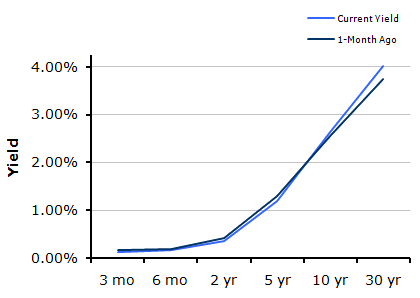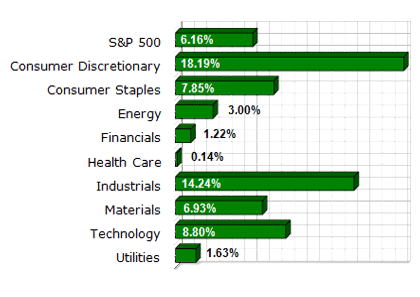
Market Commentary by Scott J. Brown, Ph.D., Chief Economist

Real GDP rose at a 2.0% annual rate in the advance estimate for Q310 (vs. +1.7% for Q210 and +3.7% for Q110) – matching the median forecast. Real consumer spending rose at a 2.6% annual rate (vs. +2.2% in Q210). Business fixed investment rose 9.7% (vs. 17.2%). A faster pace of inventory accumulation (perhaps unintended) added 1.4 percentage points to overall growth. Another increase in imports (a sign of strength in domestic demand) subtracted 2.6 percentage points from GDP, while an increase in exports added 0.6 percentage points. Domestic Final Sales (GDP less net exports and the change in inventories), the best measure of underlying domestic demand, rose at a 2.5% annual rate, down from a strong 4.3% pace reported for Q210.
The markets were buffeted by earnings reports and by shifting expectations of the Fed’s asset purchases. The consensus is that the Fed will purchase smaller amounts ($250 billion to $500 billion) of long-term Treasuries over shorter time horizons, rather than the “shock and awe” of large-scale purchases (a level of $1 trillion had been floated earlier). Market participants began to look to next week with some level of uncertainty.
Next week, the focus will be on Wednesday, with the market’s reaction to Tuesday’s election results in the morning and the Fed policy announcement in the afternoon (around 2:15 p.m.). While many races still appear tight, the market has priced in a Republican majority in the House. The Democrats are expected to retain control of the Senate, with a few lost seats, but Senate Majority Leader Harry Reid’s bid for re-election appeared to be somewhat doubtful. The Fed is widely expected to announce another round of purchases of long-term Treasuries. Friday’s employment figures will help shape the near-term economic outlook and set expectations for possible future moves by the Fed. Expect some volatility (upside and downside) in the markets.
Indices
| Last | Last Week | YTD return % | |
| DJIA | 11113.95 | 11146.57 | 6.58% |
| NASDAQ | 2507.37 | 2459.67 | 10.50% |
| S&P 500 | 1183.78 | 1180.26 | 6.16% |
| MSCI EAFE | 1616.59 | 1632.23 | 2.27% |
| Russell 2000 | 701.03 | 698.12 | 12.09% |
Consumer Money Rates
| Last | 1-year ago | |
| Prime Rate | 3.25 | 3.25 |
| Fed Funds | 0.25 | 0.25 |
| 30-year mortgage | 4.23 | 5.14 |
Currencies
| Last | 1-year ago | |
| Dollars per British Pound | 1.592 | 1.643 |
| Dollars per Euro | 1.392 | 1.473 |
| Japanese Yen per Dollar | 81.040 | 90.680 |
| Canadian Dollars per Dollar | 1.019 | 1.077 |
| Mexican Peso per Dollar | 12.402 | 13.264 |
Commodities
| Last | 1-year ago | |
| Crude Oil | 82.18 | 77.46 |
| Gold | 1340.88 | 1030.30 |
Bond Rates
| Last | 1-month ago | |
| 2-year treasury | 0.36 | 0.42 |
| 10-year treasury | 2.63 | 2.56 |
| 10-year municipal (TEY) | 4.12 | 3.88 |
Treasury Yield Curve – 10/29th/2010

S&P Sector Performance (YTD) – 10/29th/2010

Economic Calendar
| November 1st | — | Personal Income and Spending(September) Construction Spending (September) ISM Manufacturing Index (October) |
| November 2nd | — | Election Day Auto Sales (October) FOMC Policy Meeting Begins |
| November 3rd | — | Corporate Layoff Intentions (October) ADP Payrolls Estimate (October) Factory Orders (September) ISM Non-Manufacturing Index (October) FOMC Meeting |
| November 4th | — | Jobless Claims (week ending October 30th) Productivity (3Q10, preliminary) |
| November 5th | — | Employment Report (October) Pending Home Sales Index (September) |
| November 11th | — | Veterans Day (bond market closed) |
| November 15th | — | Retail Sales (October) |
| November 25th | — | Thanksgiving (market closed) |
Important Disclosures
Past performance is not a guarantee of future results. There are special risks involved with global investing related to market and currency fluctuations, economic and political instability, and different financial accounting standards. The above material has been obtained from sources considered reliable, but we do not guarantee that it is accurate or complete. There is no assurance that any trends mentioned will continue in the future. While interest on municipal bonds is generally exempt from federal income tax, it may be subject to the federal alternative minimum tax, state or local taxes. In addition, certain municipal bonds (such as Build America Bonds) are issued without a federal tax exemption, which subjects the related interest income to federal income tax. Investing involves risk and investors may incur a profit or a loss.
US government bonds and treasury bills are guaranteed by the US government and, if held to maturity, offer a fixed rate of return and guaranteed principal value. US government bonds are issued and guaranteed as to the timely payment of principal and interest by the federal government. Treasury bills are certificates reflecting short-term (less than one year) obligations of the US government.
Commodities trading is generally considered speculative because of the significant potential for investment loss. Markets for commodities are likely to be volatile and there may be sharp price fluctuations even during periods when prices overall are rising. Specific sector investing can be subject to different and greater risks than more diversified investments.
Tax Equiv Muni yields (TEY) assume a 35% tax rate on triple-A rated, tax-exempt insured revenue bonds.
![]() Material prepared by Raymond James for use by its financial advisors.
Material prepared by Raymond James for use by its financial advisors.
The information contained herein has been obtained from sources considered reliable, but we do not guarantee that the foregoing material is accurate or complete. Data source: Bloomberg, as of close of business October 28th, 2010.
©2010 Raymond James Financial Services, Inc. member FINRA / SIPC.


